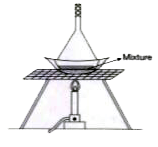Complete Solutions to EXERCISE of chapter MOCK TEST of Class 7 book with complete answers and questions
| Class 7 | CHEMISTRY |
| Chapter | MOCK TEST |
| PEARSON IIT JEE FOUNDATION | EXERCISE |
| Number Of Questions | 25 |
| Academic Year | 2023-24 |
The order of diffusion of three states of matter is `A gt B gt C`. Identify the true statement regarding A, B and C.
View SolutionA and B are two liquids at room temperature taken in containers of the same dimension and only liquid A can get converted into gaseous state below its boiling point. Identify the false statement regarding A and B.
(A) A is highly volatile and the process associated with B is quick.
(B) The process associated with A is a surface phenomenon and liquid B is less volatile.
(C) The process associated with B causes cooling and the process associated with A is boiling.
(D) The process associated with A is slow and the process associated with B is a surface phenomenon.
View SolutionFind the odd one out with respect to valency.
View SolutionFind the odd one out with respect to the number of constituent atoms.
View SolutionArrange the following compounds in the increasing order of total number of atoms.
(A) Aluminium phosphate
(B) Ammonium carbonate
(C) Magnesium sulphide
(D) Sodium bisulphate
(E) Silver nitrate
View SolutionDescriptions of some reactions are given below. Arrange them in the order of chemical displacement, decomposition, double displacement and chemical combination.
(A) Formation of precipitate.
(B) Liberation of `H_2` gas when metal reacts with acid.
(C) Formation of ammonia from nitrogen and hydrogen.
(D) Liberation of oxygen by heating of potassium nitrate.
View SolutionWhich among the following acids form one normal salt and one acidic salt?
View SolutionIdentify the electronic configuration corresponding to the element which can form neutral oxide.
View SolutionThe process where tin is used to preserve edible food materials is called……………..
View SolutionNitrogen, oxygen, helium, carbon dioxide and water vapour are the components of air. Arrange the properties given below in the order of gases given above.
(A) Colourless, odourless gas, acidic in nature, and neither combustible nor a supporter of combustion
(B) Colourless, odourless gas, inert in nature, and dilutes the activity of active component of air
Colourless gas and forms acidic and basic compounds with non-metals and metals, respectively
(D) Colourless gas, inert in nature, and present in trace amounts
(E) Gaseous form, present in variable amounts, and chemically active along with the active component of air
View SolutionPassing the hard water sample through a chemical exchanges the ions with the ion of the same charge. Identify the chemical, the ion that replaces and the type of hardness being removed.
View SolutionA little amount of sulphuric acid is added in the process of electrolytic decomposition of water. Two gases, the one liberated at negative electrode puts off the burning splinter and burns with blue flame and another gas at positive electrode, glows the burning splinter and is a non-combustible gas. The gases liberated at negative and positive electrodes, respectively, are _____ _
View SolutionA medicine, extracted from the bark of a plant, is used in the treatment of malaria. Identify the medicine.
View SolutionThe characteristic uses of the different types of construction materials are given below. Arrange them in the order of their respective names.
(A) The structural material for the construction of walls of a building
(B) Mixed with definite proportion of water, and used in filling the gaps of construction.
(C) Concrete reinforced with structural steel and is used in the construction of bridges, prefabricated structures, etc
(D) Construction material used for joining bricks and plastering.
(E) Construction material used for casting roofs, pillars and beams
(RCC, cement mortar, cement, brick and concrete)
View SolutionDetergents are superior to soaps because they ------------------.
View SolutionWhich of the following fertilizers do not replenish deficiency of nitrogen in the soil?
View SolutionArrange the following acids in the decreasing order of their basicities.
(A) Phosphoric acid
(B) Hydrochloric acid
(C) Sulphurous acid
View SolutionArrange the following indicators in the order of their colours in the acidic solution. The colours are red, pink, colourless and yellow. The indicators are
(A) Turmeric
(B) Litmus
(C) Methyl orange
(D) Phenolphthalein
View SolutionIdentify the mixture that can be separated by the diagram shown below.

View SolutionArrange the following in the order of ………….. homogeneous mixture, compound, heterogeneous mixture and element.
(A) Sugar solution
(B) Sodium
(C) Sugar
(D) Water and oil
View SolutionAtomicity of ozone is _________ .
View SolutionAtomicity of helium is ___
View SolutionIn an atom, the mass of total positive charge present is 7348 times to that of the mass of a negatively charged particle. What is the atomic number of the element? `(m_(e )= 9.1xx 10^(-31)kg, m_(p)= 1.67xx 10^(-27)kg)`.
View SolutionThe maximum number of electrons that can be accommodated in M-shell is………
View SolutionIn the combustion reaction `C_(3)H_(8)+O_(2) to CO_(2)+H_(2)O`, the coefficient for `O_2` is
View Solution
EXERCISE questions and complete solutions for chapter MOCK TEST of PEARSON IIT JEE FOUNDATION of Class 7